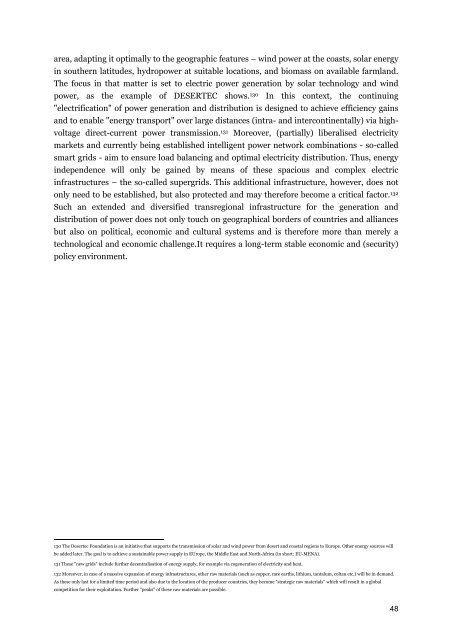PEAK OIL
PEAK OIL
PEAK OIL
You also want an ePaper? Increase the reach of your titles
YUMPU automatically turns print PDFs into web optimized ePapers that Google loves.
area, adapting it optimally to the geographic features – wind power at the coasts, solar energy<br />
in southern latitudes, hydropower at suitable locations, and biomass on available farmland.<br />
The focus in that matter is set to electric power generation by solar technology and wind<br />
power, as the example of DESERTEC shows. 130 In this context, the continuing<br />
"electrification" of power generation and distribution is designed to achieve efficiency gains<br />
and to enable "energy transport" over large distances (intra- and intercontinentally) via highvoltage<br />
direct-current power transmission. 131 Moreover, (partially) liberalised electricity<br />
markets and currently being established intelligent power network combinations - so-called<br />
smart grids - aim to ensure load balancing and optimal electricity distribution. Thus, energy<br />
independence will only be gained by means of these spacious and complex electric<br />
infrastructures – the so-called supergrids. This additional infrastructure, however, does not<br />
only need to be established, but also protected and may therefore become a critical factor. 132<br />
Such an extended and diversified transregional infrastructure for the generation and<br />
distribution of power does not only touch on geographical borders of countries and alliances<br />
but also on political, economic and cultural systems and is therefore more than merely a<br />
technological and economic challenge.It requires a long-term stable economic and (security)<br />
policy environment.<br />
130 The Desertec Foundation is an initiative that supports the transmission of solar and wind power from desert and coastal regions to Europe. Other energy sources will<br />
be added later. The goal is to achieve a sustainable power supply in EUrope, the Middle East and North-Africa (in short: EU-MENA).<br />
131 These "new grids" include further decentralisation of energy supply, for example via cogeneration of electricity and heat.<br />
132 Moreover, in case of a massive expansion of energy infrastructures, other raw materials (such as copper, rare earths, lithium, tantalum, coltan etc.) will be in demand.<br />
As these only last for a limited time period and also due to the location of the producer countries, they become "strategic raw materials" which will result in a global<br />
competition for their exploitation. Further "peaks" of these raw materials are possible.<br />
48


